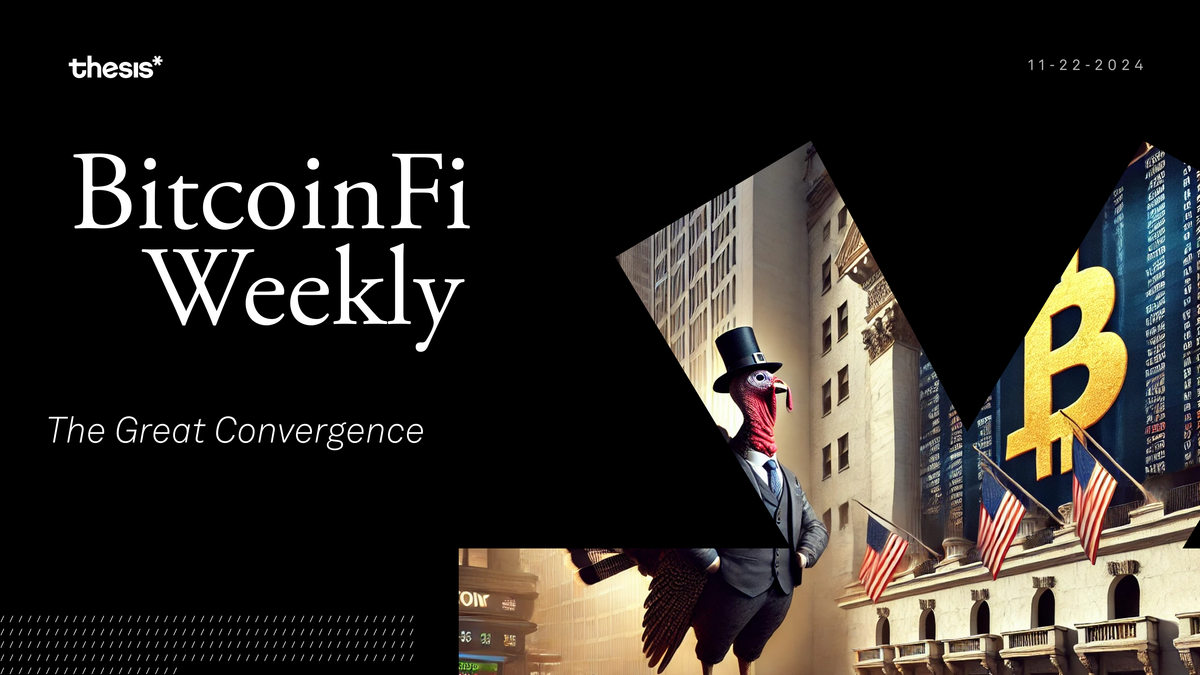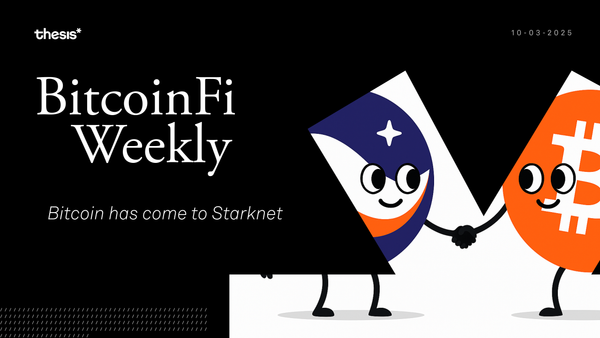The Great Convergence
Projects like Mezo and Fiamma Bridge are rewriting the playbook for community-driven utility and trust-minimized bridging, while Side Protocol’s vision for onchain Bitcoin banking lays the foundation for a new financial paradigm. As Bitcoin’s institutional and onchain. Stay bold, BitcoinFi.

Welcome to BitcoinFi Weekly. We cover where people use their BTC and what is changing in the Bitcoin world.
You know what's funny about revolutions? They rarely announce themselves with fanfare. Sometimes they slip in through the back door, wearing a suit and tie, speaking the language of options contracts and basis trades. That's what we're seeing right now in the world of Bitcoin – not on the streets of El Salvador or in the digital valleys of crypto Twitter, but in the sterile, fluorescent-lit halls of the Nasdaq. It seems we are witnessing, what some call, the Great Convergence of Bitcoin and TradFi.
On Tuesday, November 19th, the Nasdaq made history by listing options on BlackRock’s $44 billion spot Bitcoin ETF. More than 80% of day-one volumes were call orders. And this is only the beginning. In a matter of days, ten more issuers will join the fray, with additional listings on the NYSE to follow. The street, in its infinite wisdom or perhaps its infinite greed, is betting big on more upside. But this isn't just another day in paradise.
The real action, the story nobody's telling you about, is in the native cost of capital. See, in the wild days of 2021, when the funding rates hit astronomical levels, you needed brass balls and a death wish to arbitrage these markets. The only players were crypto natives and offshore exchanges; we all know how that story ended.
But now? Now we've got CME futures that are more liquid than ever, ETF options fresh off the press, and a whole new framework for margin trading. The walls between TradFi and crypto are being systematically dismantled by the very institutions that once mocked this whole endeavor. When you see MicroStrategy pulling off a $3 billion 0% coupon convertible that's oversubscribed at a 55% premium, you know the game has fundamentally changed.
This week, we spotlight Pendle’s bold leap into BitcoinFi, alongside game-changing updates from tBTC, new BitcoinFi protocols, and more.
Here’s this week’s rundown:
🌌 Feature Piece: Pendle’s Path to BitcoinFi
🟥 Mezo Launches Matsnet Alpha
🛡️ tBTC Update: A Bold Proposal to Eliminate $T Inflation
🏦 Side Protocol Unveils OnChain Banking for Bitcoin
📚 New Research on Permissionless BTC-Secured Loans
🌉 Fiamma: A New BitVM-powered Bridge
Feature Piece: Pendle’s Path to BitcoinFi
In the short, but kaleidoscopic history of crypto, certain patterns reveal themselves like constellations in a chaotic night sky. We see moments of brilliance and periods of darkness—bull markets that embolden pioneers, bear markets that test their mettle. Listening to TN, co-founder of Pendle, on the lastest episode of the BitcoinFi podcast, I couldn’t help but marvel at the cyclical beauty of it all: how the hard lessons of 2019 have given way to an ecosystem teeming with ambition and experimentation.
Pendle's journey from a modest DeFi protocol to managing billions in TVL exemplifies the maturation of crypto markets. TN’s journey began in 2017 at Kyber, a time when DeFi was nascent and uncertain. The market’s collapse in 2018 forced him and many others to reckon with a sobering truth: the infrastructure wasn’t ready. But from that crucible came clarity. By the time DeFi Summer 2020 rolled around, TN and his team were poised to build something meaningful.
The Rise of Points and Pendle’s Big Break
Fast forward to 2024, and Pendle’s trajectory feels almost inevitable. This year, the protocol exploded from $200 million in total value locked (TVL) at the start of the year to $6.7 billion by the summer. The catalyst? A confluence of “points,” staking narratives, and the growing sophistication of DeFi.
Points, as TN explains, were the natural evolution of the incentive structures that powered DeFi in its infancy. They filled a void left by the decline of ICOs and token launches, offering users a way to engage without the regulatory baggage of issuing tokens outright. Pendle capitalized on this zeitgeist, tokenizing points and creating a market for traders to speculate, hedge, or leverage their positions.
It’s a clever strategy, but one that TN acknowledges has matured. The frothiness of early 2024 has given way to a more stable, efficient market. Points, while no longer commanding the outsized premiums of six months ago, remain a powerful mechanism for bootstrapping liquidity and gauging market sentiment.
BitcoinFi: Pendle’s Next Frontier
What’s most compelling, though, is Pendle’s pivot toward BitcoinFi. TN, like many early crypto adopters, has a deep reverence for Bitcoin. Yet he’s also pragmatic about its limitations. Bitcoin, for all its virtues, lacks the native yield opportunities of proof-of-stake networks like Ethereum.
Pendle aims to bridge that gap by tokenizing Bitcoin yields, unlocking new avenues for BTC holders to generate returns without compromising the asset’s ethos. As TN notes, the emergence of protocols like Mezo and Thesis, coupled with the growing adoption of tokenized Bitcoin, has created fertile ground for experimentation. The next 6–12 months will be critical as protocols vie to establish dominance in this burgeoning space.
Lessons from the Pendle Playbook
TN’s reflections on Pendle’s journey offer valuable insights for builders and investors alike. First, innovation thrives in cycles. Bear markets are for building; bull markets are for scaling. Pendle’s ability to adapt to changing narratives—whether it’s points, staking, or BitcoinFi—has been a key driver of its success.
Second, product-market fit is everything. Pendle’s early struggles with traction underscore the importance of timing and focus. By aligning its offerings with market demand—be it tokenized staking yields or leveraged points trading—the protocol has carved out a niche that resonates with both retail and institutional users.
Finally, simplicity scales. Pendle’s core proposition—splitting yield-bearing assets into tradable components—has remained remarkably consistent since its inception. This focus on a clear, compelling use case has enabled the team to iterate without losing sight of their vision.
The Road Ahead
As we look to 2025, Pendle’s ambitions are far from realized. The upcoming V3 update promises to introduce leverage, expanding the protocol’s utility and appeal. Meanwhile, the team is exploring new frontiers, from proof-of-stake yields to potential applications in Bitcoin mining.
TNs optimism is infectious, but it’s grounded in hard-earned experience. “Bitcoin was the first thing I ever bought,” he says, reflecting on the white paper that first drew him into the space. That sense of wonder, tempered by years of trial and error, is what makes Pendle’s story so compelling.
In a world where hype often outpaces substance, Pendle stands out as a protocol that delivers. The question now isn’t whether Pendle will succeed—it’s how far they can go.
BitcoinFi Updates
Mezo Launches Matsnet Alpha
Welcome to matsnet Alpha, Mezo's new testnet environment where community points evolve into something more substantial - a working model of BitcoinFi’s future playground.Mats, or “magic satoshis,” have long been the playful heartbeat of Mezo’s community, rewarding users for creativity, engagement, and camaraderie. But with matsnet Alpha, mats gain utility like never before: they can now be converted into matsnet BTC, a testnet version of Bitcoin that mirrors real BTC functionality.
With matsnet Alpha, users can earn mats through Discord memes, community events, or direct BTC deposits, and then use them to stack sats, trade in the mats Meme Market, or climb the Stack Rank leaderboard. Whether it’s through tipping, gaming, or strategic trading, matsnet BTC opens up endless opportunities for experimentation in a mainnet-like test environment.
From hackathons to dapps powered by matsnet BTC, this testnet lays the foundation for a new era of decentralized collaboration.
tBTC Update: A Bold Proposal to Eliminate $T Inflation
Threshold Network’s TIP-092 aims to eliminate $T token inflation by transitioning from the current emission-based "Stable Yield" model to a leaner Beta Staker program. Currently, inflation costs the network $12.5 million annually, with a 5% dilution rate to incentivize stakers. The proposal would replace these emissions with direct payments to Beta Stakers, totaling $500,000 annually, funded by reinstated minting and redemption fees. This shift could render tBTC protocol-level profitable and allow surplus fees to fund a $T buyback program, introducing a deflationary dynamic for the token.TIP-092 would enable immediate unstaking for non-Beta Stakers, consolidate Beta Staker nodes to one per operator, and safely transition deprecated nodes out of active tBTC wallets and TACo cohorts. By significantly reducing inflationary costs while maintaining robust network security, the proposal sets the stage for a more efficient and scalable Threshold.
As the network evolves toward permissionless signing with BitVM2 vaults, TIP-092 positions Threshold to lead as a deflationary, high-value ecosystem.
Side Protocol Unveils OnChain Banking for Bitcoin
Side Protocol claims to be the “first fully Bitcoin-compatible Layer 1 blockchain”, offering self-custody, decentralized banking infrastructure. Anchored by Side Finance, a non-custodial, liquidity-based lending system, and Side Chain, a scalable Bitcoin-compatible appchain, the protocol aims to make a splash in the BitcoinFi arena.
At the core of Side Finance is a lending system that allows BTC holders to collateralize their assets without third-party custody. The protocol secures all BTC collateral using 2-of-2 multisignature addresses, ensuring that funds cannot be spent arbitrarily. It integrates advanced Bitcoin-native technologies, including Schnorr-based Adaptor Signatures, Taproot, Hash Time-Locked Contracts (HTLCs), and Discreet Log Contracts (DLCs), to provide smart contract-like functionality without altering Bitcoin’s base protocol. The use of liquidity pools enhances efficiency and composability, offering a scalable alternative to peer-to-peer lending systems that have struggled to achieve product-market fit.
Recently, Side Protocol announced an upcoming token generation event (TGE) for $SIDE, the protocol’s native utility token. Serving as the backbone of Side Protocol’s ecosystem, $SIDE aligns incentives across builders, network operators, and users. While Bitcoin remains the primary asset across Side Protocol’s products, $SIDE functions as the utility and governance token, driving value accrual, securing the network through staking, and enabling decentralized governance. Revenue generated from Side Protocol’s ecosystem—including Side Finance, Side Chain, Side Bridge, the native DEX, and future offerings—will fuel a buyback-and-burn mechanism, creating a deflationary dynamic that enhances $SIDE’s value. Additionally, $SIDE can be used alongside BTC to pay network transaction fees, rewarding participants and ensuring robust network security.
The TGE follows a unique two-phase launch strategy, beginning on Solana to leverage its liquidity and high activity. This ensures accessibility and broad distribution for early adopters. When the Side Chain mainnet launches in January 2025, $SIDE tokens issued on Solana will be convertible to native mainnet tokens, unlocking staking rewards and full governance participation. The transition reflects Side Protocol’s focus on seamless user experience and strategic growth.
New Research on Permissionless BTC-Secured Loans
A new research report by Bedlam Research addresses a fundamental challenge in the Bitcoin ecosystem: despite Bitcoin's $1.9T market cap and representing 60% of all crypto market cap, less than 20% of the $43B in onchain lending TVL is Bitcoin-secured. The research presents three potential architectures for permissionless Bitcoin-secured lending, each with distinct tradeoffs.
Here’s the TLDR:
System 1 (ZK rollup with overcollateralized stablecoin) represents an ideal, but currently, theoretical solution. System 2 (wrapped BTC on other chains) reflects the current predominant but trust-dependent approach. System 3 presents a middle-ground solution that maintains BTC on Bitcoin while enabling borrowing on other chains.
What's particularly insightful about this analysis is how it frames the fundamental challenge: Bitcoin's consensus rules don't recognize external assets, forcing any lending system to handle cross-domain interactions. The report uses three key evaluation criteria (bridge security, collateralization domain, and borrowed asset) to systematically compare approaches. While System 1 appears technically superior with its validating bridge and forced exits, its theoretical nature highlights the gap between ideal and currently implementable solutions. System 3's approach of keeping BTC on Bitcoin while managing positions through a separate system represents an interesting compromise, though it introduces its own complexity with cross-domain liquidations and position management.
This piece is particularly relevant given the recent surge in Bitcoin's institutional adoption through ETFs. However, as the report notes, the goal should be to bring traditional finance onchain rather than simply export Bitcoin to traditional finance - a reminder of the crypto industry's original cypherpunk vision.
Fiamma: A New BitVM-powered Bridge
Fiamma Bridge has been introduced as a significant advancement in Bitcoin bridging, leveraging BitVM2 to create a "trust-minimized" bridge solution. The key innovation lies in their approach to shared custody and ZK proof verification, addressing how to enable cross-chain interactions without compromising Bitcoin's security model. Their technical architecture employs a three-pronged approach: shared custody addresses, ZK proofs for withdrawal verification, and a novel implementation of BitVM2 that breaks ZK verifiers into sequential fragments to overcome Bitcoin's computational limitations.
This project is distinguished from traditional Bitcoin bridges by eliminating multisigs or centralized intermediary reliance. Instead, the system maintains Bitcoin consensus as the arbiter while enabling cross-chain functionality through what they call "pragmatically trustless" architecture. The design allows users to retain significant control over their BTC while participating in DeFi activities across other chains, with the innovation of Bitcoin being able to verify and punish malicious behavior in cross-chain transfers - a capability that wasn't previously possible.
The project's roadmap reveals broader ambitions beyond just bridging, with plans to develop a comprehensive infrastructure stack including a ZKP verification layer and additional BitVM-powered tools. The team is taking a methodical approach to testing, particularly with their upcoming "unhappy path" testing phase that will allow community members to attempt to challenge and break the system.
Closing Thoughts
This week’s BitcoinFi Weekly brings us to a tipping point where innovation meets maturation. From Nasdaq's groundbreaking options debut to Pendle's ambitious leap into BitcoinFi, the boundaries of what's possible with Bitcoin are expanding before our eyes. Projects like Mezo and Fiamma Bridge are rewriting the playbook for community-driven utility and trust-minimized bridging, while Side Protocol’s vision for onchain Bitcoin banking lays the foundation for a new financial paradigm.
As Bitcoin’s institutional and onchain ecosystems converge, we’re witnessing the dawn of a more integrated, robust financial future. Stay bold, BitcoinFi. The walls of Troy have indeed been breached, and the real revolution is just beginning.
Thank you for tuning in to this week’s BitcoinFi Weekly. See you next week.
If there's a topic you’d like us to cover or have questions, reach out at [email protected].
Learn more about Mezo at the following channels:
👾 Discord: https://discord.mezo.org
🕊 X: https://twitter.com/MezoNetwork
🖥 Website: https://mezo.org
🏦 Deposit Portal: https://mezo.org/hodl
ℹ️ Docs: https://info.mezo.org





